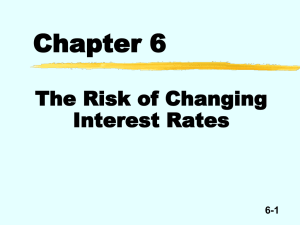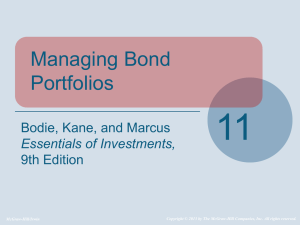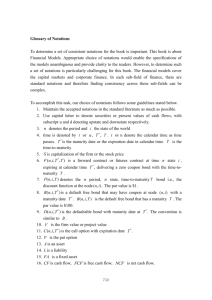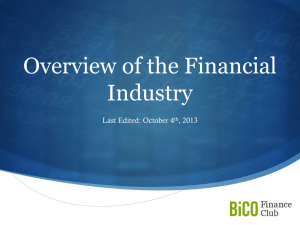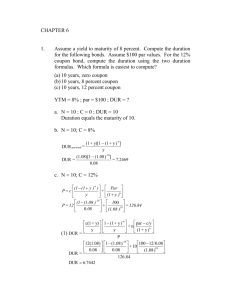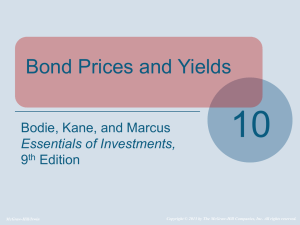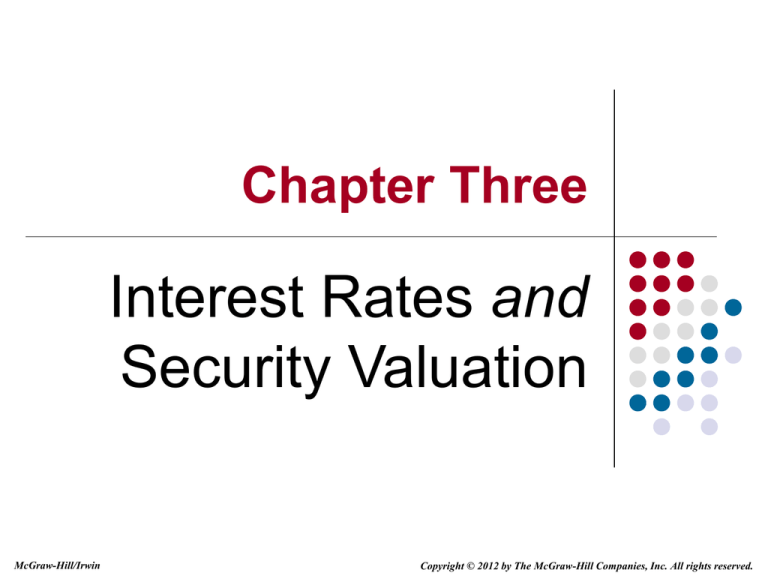
Chapter Three
Interest Rates and
Security Valuation
McGraw-Hill/Irwin
Copyright © 2012 by The McGraw-Hill Companies, Inc. All rights reserved.
Various Interest Rate Measures
Coupon rate
Required rate of return (r)
rates used by individual market participants to calculate
fair present values (PV)
Expected rate of return or E(r)
periodic cash flow a bond issuer contractually promises to
pay a bond holder
rates participants would earn by buying securities at
current market prices (P)
Realized rate of return ( r )
rate actually earned on investments
3-2
Required Rate of Return
The fair present value (PV) of a security is
determined using the required rate of return (r) as
the discount rate
~
~
~
~
CF1
CF2
CF3
CFn
PV
...
(1 r )1 (1 r )2 (1 r )3
(1 r )n
CF1 = cash flow in period t (t = 1, …, n)
~ = indicates the projected cash flow is uncertain
n = number of periods in the investment horizon
3-3
Expected Rate of Return
The current market price (P) of a security is
determined using the expected rate of return or
E(r) as the discount rate
P
~
CF1
1
(1 E(r ))
~
CF2
2
(1 E(r ))
~
CF3
3
(1 E(r ))
...
~
CFn
(1 E(r ))n
CF1 = cash flow in period t (t = 1, …, n)
~ = indicates the projected cash flow is uncertain
n = number of periods in the investment horizon
3-4
Realized Rate of Return
The realized rate of return ( r ) is the discount rate
that just equates the actual purchase price ( P) to
the present value of the realized cash flows (RCFt) t
(t = 1, …, n)
P
RCF1
RCF2
(1 r )1 (1 r )2
RCF3
(1 r )3
...
RCFn
(1 r )n
3-5
Bond Valuation
The present value of a bond (Vb) can be written as:
t
INT 2T
1
Par
Vb
2 t 1 (1 (r / 2)) (1 (r / 2))2T
INT
2
1 1 (1 (r 2))2T
Par
(r 2)
(1 (r/2))2T
Par = the par or face value of the bond, usually $1,000
INT = the annual interest (or coupon) payment
T = the number of years until the bond matures
r = the annual interest rate (often called yield to maturity (ytm))
3-6
Bond Valuation
A premium bond has a coupon rate (INT)
greater than the required rate of return (r) and
the fair present value of the bond (Vb) is
greater than the face or par value (Par)
Premium bond: If INT > r; then Vb > Par
Discount bond: if INT < r, then Vb < Par
Par bond: if INT = r, then Vb = Par
3-7
Equity Valuation
The present value of a stock (Pt) assuming zero
growth in dividends can be written as:
Pt D / rs
D = dividend paid at end of every year
Pt = the stock’s price at the end of year t
rs = the interest rate used to discount future cash flows
3-8
Equity Valuation
The present value of a stock (Pt) assuming
constant growth in dividends can be written as:
t
D0 (1 g)
Dt 1
Pt
rs g
rs g
D0 = current value of dividends
Dt = value of dividends at time t = 1, 2, …, ∞
g = the constant dividend growth rate
3-9
Equity Valuation
The return on a stock with zero dividend growth, if
purchased at current price P0, can be written as:
rs D / P0
The return on a stock with constant dividend growth,
if purchased at price P0, can be written as:
D (1 g)
D
rs 0
g 1g
P0
P0
3-10
Relation between Interest Rates
and Bond Values
Interest
Rate
12%
10%
8%
874.50
1,000
1,152.47
Bond Value
3-11
Impact of Maturity on Price
Volatility (a)
Absolute Value of
Percent Change in a
Bond’s Price for a
Given Change in
Interest Rates
Time to Maturity
3-12
Impact of Maturity on Price
Volatility (b)
Coupon
Par
yield rate old
yield rate change
yield rate new
$
6.00%
1,000
7.00%
0.50%
7.50%
Absolute
Price old
Price new Rate of change
1 $ 990.65 $ 986.05
0.47%
5 $ 959.00 $ 939.31
2.05%
10 $ 929.76 $ 897.04
3.52%
15 $ 908.92 $ 867.59
4.55%
20 $ 894.06 $ 847.08
5.25%
25 $ 883.46 $ 832.80
5.74%
30 $ 875.91 $ 822.84
6.06%
35 $ 870.52 $ 815.91
6.27%
40 $ 866.68 $ 811.08
6.42%
45 $ 863.94 $ 807.72
6.51%
50 $ 861.99 $ 805.38
6.57%
55 $ 860.60 $ 803.75
6.61%
60 $ 859.61 $ 802.61
6.63%
65 $ 858.90 $ 801.82
6.65%
70 $ 858.40 $ 801.27
6.66%
75 $ 858.04 $ 800.88
6.66%
80 $ 857.78 $ 800.61
6.66%
85 $ 857.60 $ 800.43
6.67%
90 $ 857.47 $ 800.30
6.67%
95 $ 857.37 $ 800.21
6.67%
100 $ 857.31 $ 800.14
6.67%
105 $ 857.26 $ 800.10
6.67%
Predicted limit price change =
1 - (r old / r new)
6.67%
Maturity
IM Figure 3.1
3-13
Impact of Coupon Rates on
Price Volatility
Bond
Value
High-Coupon Bond
Low-Coupon Bond
Interest Rate
3-14
Impact of Coupon on Price
Volatility (b)
Coupon
Par
rate old
rate change
rate new
Varies
$1,000
7.00%
-0.50%
6.50%
Maturity
10 years
Absolute
Rate of
Coupon rate
Price old
Price new
change
6.00%
$ 929.76
$ 964.06
3.69%
5.50%
$ 894.65
$ 928.11
3.74%
5.00%
$ 859.53
$ 892.17
3.80%
4.50%
$ 824.41
$ 856.22
3.86%
4.00%
$ 789.29
$ 820.28
3.93%
3.50%
$ 754.17
$ 784.34
4.00%
3.00%
$ 719.06
$ 748.39
4.08%
2.50%
$ 683.94
$ 712.45
4.17%
2.00%
$ 648.82
$ 676.50
4.27%
1.50%
$ 613.70
$ 640.56
4.38%
1.00%
$ 578.59
$ 604.61
4.50%
0.50%
$ 543.47
$ 568.67
4.64%
0.00%
$ 508.35
$ 532.73
4.80%
IM Figure 2 Coupons and Price Volatility
3-15
Impact of r on Price Volatility
Bond Price
How does volatility change with
interest rates?
Price volatility is
inversely related
to the level of the
initial interest
rate
Interest Rate
r
3-16
Duration
Duration is the weighted-average time to
maturity (measured in years) on a financial
security
Duration measures the sensitivity (or
elasticity) of a fixed-income security’s price to
small interest rate changes
Duration captures the coupon and maturity
effects on volatility.
3-17
Duration
Duration (Dur) for a fixed-income security that pays interest
annually can be written as:
T
CF t t
(1 r )t
Dur t 1
P0
T
PVt t
t 1
P0
P0= Current price of the security
t = 1 to T, the period in which a cash flow is received
T = the number of years to maturity
CFt = cash flow received at end of period t
r = yield to maturity or required rate of return
PVt = present value of cash flow received at end of period t
3-18
Duration and Volatility
9% Coupon, 4 year maturity annual payment bond with a 8% ytm
T
CF t
(1tr)t
Dur t 1
P0
Year (T)
1
2
3
4
Totals
Cash Flow
$ 90
90
90
$1090
PV @8%
CFT/(1+r)T
$ 83.33
77.16
71.45
$ 801.18
$1033.12
% of Value
PV/Price
8.06%
7.47%
6.92%
77.55%
100.00%
Weighted % of
Value
(PV/Price)*T
0.0806
0.1494
0.2076
3.1020
3.5396
Duration = 3.5396 years
3-19
Duration
Duration (Dur) (measured in years) for a fixedincome security, in general, can be written as:
T
CF t t
(1 r / m )
t
1
/
m
Dur
P0
mt
m = the number of times per year interest is paid, the sum
term is incremented in m units
3-20
Closed form duration equation:
1 (1 r) N
PVIFA r, N
r
INT
Dur N
N ((1 r) PVIFA r,N )
(Po r)
• P0 = Price
• INT= Periodic cash flow in dollars, normally the semiannual coupon on
a bond or the periodic monthly payment on a loan.
• r = periodic interest rate = APR / m, where m = # compounding periods
per year
• N = Number of compounding or payment periods (or the number of
years * m)
• Dur = Duration = # Compounding or payment periods; Durationperiod is
what you actually get from the formula
3-21
Duration
Duration and coupon interest
Duration and yield to maturity
the higher the coupon payment, the lower the bond’s
duration
the higher the yield to maturity, the lower the bond’s
duration
Duration and maturity
duration increases with maturity but at a decreasing rate
3-22
Duration and Modified Duration
Given an interest rate change, the estimated
percentage change in a (annual coupon paying)
bond’s price given by
P
r
Dur
P
1 r
3-23
Duration and Modified Duration
Modified duration (DurMod) can be used to predict price
changes for non-annual payment loans or securities:
It is found as:
where rperiod = APR/m
DurMod
DurAnnual
(1 rperiod )
Using modified duration to predict price changes:
ΔP
DurMod Δrannual
P
3-24
Duration Based Prediction Errors
3-25
Convexity
Convexity (CX) measures the change in slope of
the price-yield curve around interest rate level R
Convexity incorporates the curvature of the priceyield curve into the estimated percentage price
change of a bond given an interest rate change:
P
r 1
2
Dur
CX
(
r
)
P
1 r 2
3-26
Practice Problem
P0
$C
Dur
N
N
((1
r)
PVIFA
)
r,N
1 1.03510 $1000
(P
r)
$30
$958.42
o
10
0.035
1.035
$30
Dursemi 10
10 (1.035 8.316605) 8.7548 six monthperiods
($958.42 0.035)
Δrsemi
0.0025
ΔP
8.7548
2.1147%
Dursemi
1.035
P
(1 roldsemi)
P1 Predicted $958.42 (1 0.021147) $938.15
Using Modified Duration
DurMod
DurAnnual
4.3774
(8.7548 / 2)
4.2294
(1 rperiod )
1.035
1.035
Predicted Price Change Using Modified Duration
ΔP
DurMod Δrannual 4.2294 0.0050 2.1147%
P
3-27



